My favourite way to describe yellow perennial flowers is as sunshine in the garden. They may sound cheesy but they are brilliant lights in a perennial bed. The garden’s beautiful tapestry of flowers is accentuated by the stunning golden tones, which contrast sharply with the other bloom colours.
One of the most beloved hues for enthusiastic gardeners is yellow. Yellow flowers are among the most noticeable plants in nature, and the colour yellow is said to convey energy and hope.
There’s no shortage of yellow perennial flowers to pick from for your yard. For your garden, we chose a variety of 20 yellow perennial flowers.
1. Firefly Sunshine
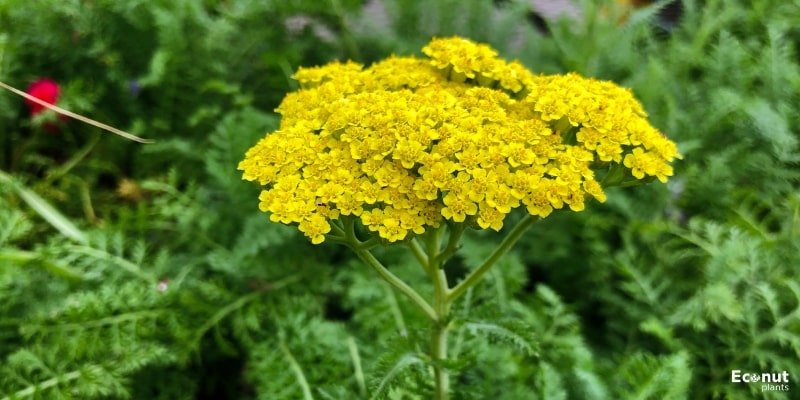
Scientific Name: Achillea
For sun-loving gardeners, Firefly Sunshine is the best choice because it has the longest-lasting colour in the yarrow family. It blooms copiously on stiff stems, which is ideal for dried bouquets or cut flowers. Small and vivid yellow solitary flowers with bobbly centers that stand out against the grey-green leaves. It can get as high as thirty inches.
The Firefly Sunshine is a great flower for borders. Its upright habit also makes it perfect for producing the ribbon looks that were previously explained. Zones 3 to 8 are ideal for this flower. It should be grown in well-drained, typical, or poor soil and requires full to partial light. Rich soil doesn’t help it too much. Cut the plant in half when the flowers finish preparing it for future years.
2. Forsythia

Scientific Name: Achillea millefolium
One of my favourite bushes to bloom in the spring is forsythia. In April, depending on the year, it usually blooms. I enjoy bringing in branches that I’ve clipped from my backyard, and when they finally blossom outside, they pop.
As the blossoms for next year form on this year’s branches, make sure you cut them as soon as the blooms have fallen off. It is little more than a lovely green, leafy shrub during the summer. Moreover, the deer don’t bother with the forsythia when they come into my yard in the winter to munch on my cedars.
3. Corn Marigold
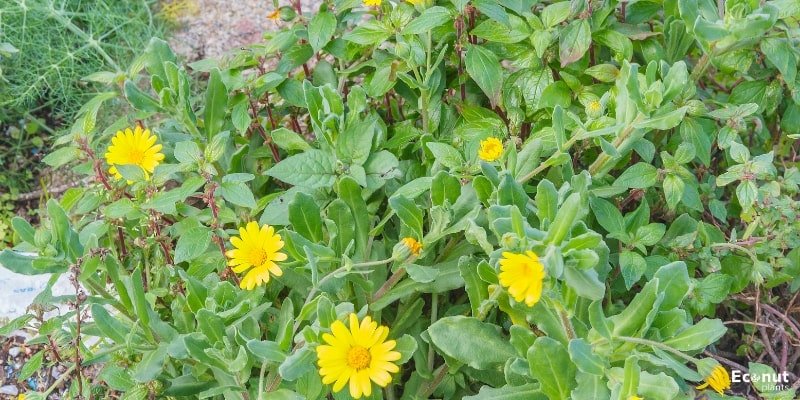
Scientific Name: Glebionis Segetum
Corn marigold is not a truly native flower, although it has become fully naturalized throughout much of northern Europe today. It features medium-sized, upright stems that tip off in beautiful yellow discs that resemble daisies. It thrives in most types of soil, but not in alkaline soils, and it needs as much sunlight as possible.
Its striking yellow blossoms, which bloom from late spring to early autumn, are accentuated by the bluish-green foliage that has a waxy coating and a pleasant scent. The plant attracts a lot of bees and butterflies, which makes it an excellent pollinator that promotes biodiversity in gardens.
4. False Sunflower
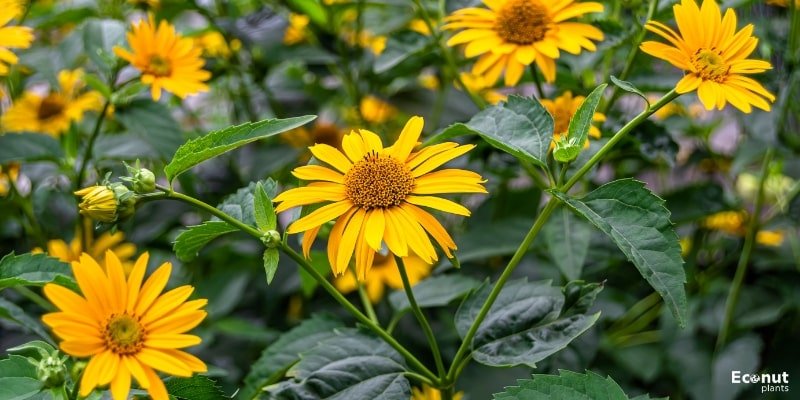
Scientific Name: Heliopsis Helianthoides
False Sunflower has eyes the same colour as the flowers, which are brilliant yellow with golden centers. This plant makes a great bouquet maker because of its huge blossoms. It blooms from mid-to-late summer and grows well in zones 4–9. It can withstand both full sun and moderate shade.
5. Hellebores
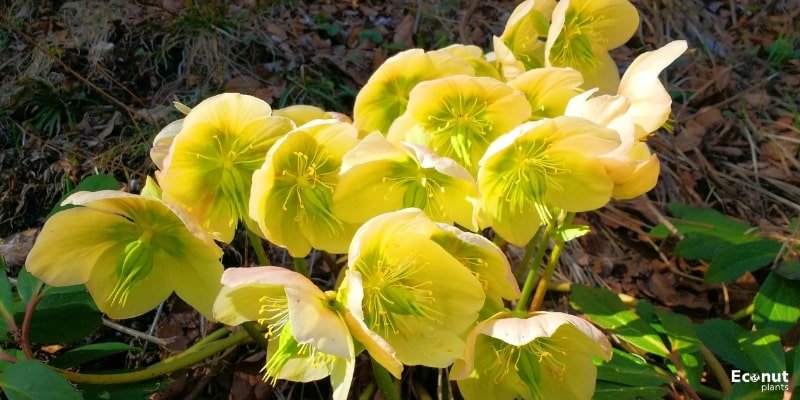
Scientific Name: Helleborus
With their graceful golden blossoms, hellebores, sometimes referred to as Lenten roses, are lovely perennial flowers that add brightness to any garden. This perennial shields a ring of tiny stamen-like petals with its leathery leaves.
Hellebores bloom for a long time, ranging in colour from white to purple over six to eight weeks. For optimal results, I suggest planting them in partially shaded, well-draining soil. Although they require regular moisture and flourish in cool weather, hellebores should not be overwatered since this can lead to root rot.
These hardy plants are typically disease- and pest-resistant and require little upkeep. In addition, trimming the withered leaves and blossoms in the early spring promotes new development and keeps them looking tidy.
6. Black Eyed Susan

Scientific Name: Rudbeckia hirta
These bright yellow blooms will make your garden shine from mid-summer until fall. In contrast to the low, clumping foliage, the flowers are fairly tall. Take a look at the tag; some are biennials or annuals with limited lifespans, while others are long-living perennials. Bonus: Over time, they will produce additional free plants because they reseed. Let the sun shine on them.
7. Tickseed

Scientific Name: Coreopsis spp.
Another Native American who enjoys the sun is Coreopsis. Hardy in zones 4 through 9, this perennial reaches a height of 18 to 24 inches; if you’d rather have a smaller variety, dwarf varieties reach a height of only 6 to 12 inches. This plant needs full light for at least six to eight hours each day.
Water Coreopsis if the soil seems dry to the touch. This plant enjoys rich, well-drained soil. When the risk of frost has passed, spring is the ideal season to grow coreopsis. The second year after planting, you will begin to receive your first flowers. To encourage extended bloom periods, trim off any fading flowers.
8. Yellow Daylily
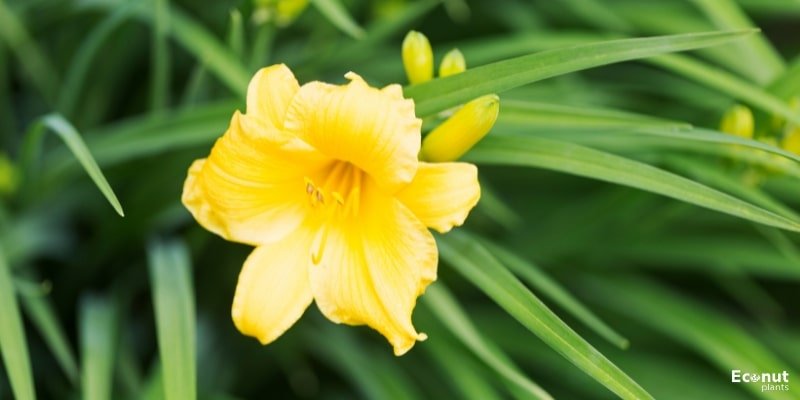
Scientific Name: Hemerocallis spp.
The hardy perennial yellow daylily features spikes of trumpet-shaped flowers in yellow, gold, and orange hues. They adore full light and soil that drains well. They smell as good as they look, and they will bloom all summer long.
9. Button Style Chrysanthemum
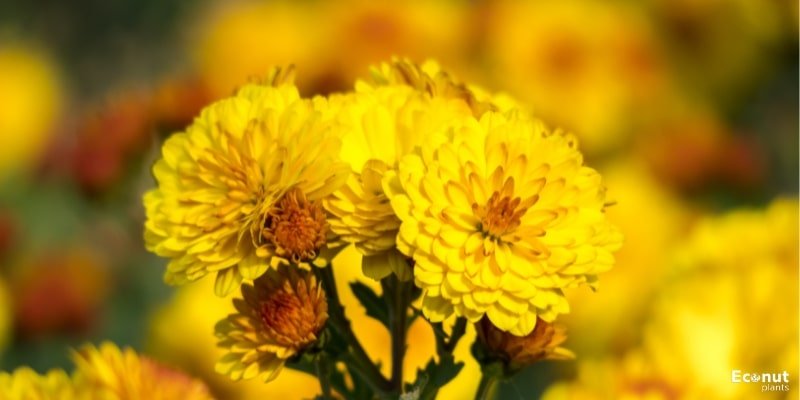
Scientific Name: Chrysanthemum ×grandiflorum
Small, button-like flowers in a range of colours, including yellow, bloom on these perennial yellow blossoms. It is a great option for cottage gardens and varied border plantings.
10. Evening Primrose

Scientific Name: Qenothera biennis
Oenothera biennis, or evening primrose, is a yellow perennial flower that enjoys sun exposure. Its yellow blooms, which are native to North America, open at sunset, giving rise to the name of the plant, and continue to shine for several hours until early dawn.
Growing requirements for this gem are as straightforward as they come: lots of full sun, mild temperatures, and soil that is moist but drains well.
With minimal maintenance on your part, you may enjoy its scent and gorgeous golden glow throughout the summer months! All it needs is some love and care!
11. Coneflower
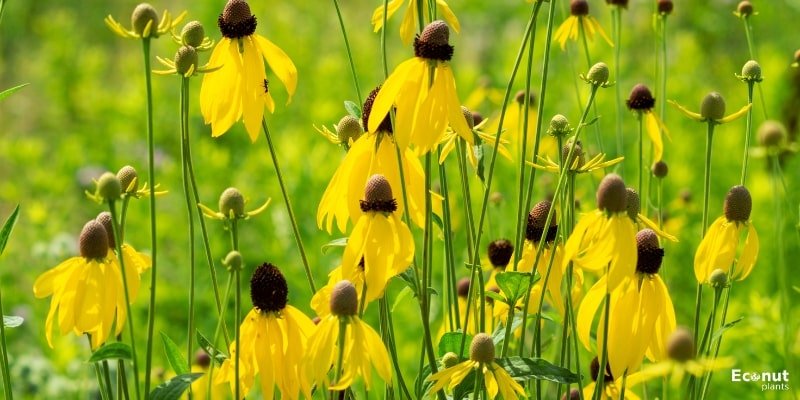
Scientific Name: Echinacea
Perennial yellow coneflowers, or Rudbeckia, thrive best in well-drained, dry soil that is not too rich, especially when grown in full sun for an abundance of yellow blossoms. To encourage more blooms, it’s a terrific idea to pluck part of the blossoms.
12. Yellow Honeysuckle

Scientific Name: Lonicera flava
Like the Japanese honeysuckle, this yellow perennial flowering vine is not invasive. It is indigenous to the central and southeast regions of the United States.
The elliptic, green leaves of yellow honeysuckles have a grayish-green underside, and their vivid yellow blooms eventually become red. The flowers are mildly aromatic. The blossoms of the honeysuckle attract butterflies and hummingbirds.
13. ‘Hello Yellow’ Butterfly Weed

Scientific Name: Asclepias tuberosa ‘Hello Yellow’
Hello, Yellow butterfly weed is a shrubby perennial that looks great. It’s perfect for adding vivid colour to difficult environments like dry or salty soil or if you have deer visiting your garden. Herbaceous and low-growing, it produces stiff, long, oval leaves that are mid-green in thick clumps.
In summer, when the Sun is strong, clusters of intensely yellow flowers can be seen. They are tiny, star-shaped flowers with long petals that resemble rays and a tiny crown in the middle.
Growing this plant can also benefit the environment because it is vital to the survival of monarch butterflies, which might visit your garden!
14. Lemon Meringue
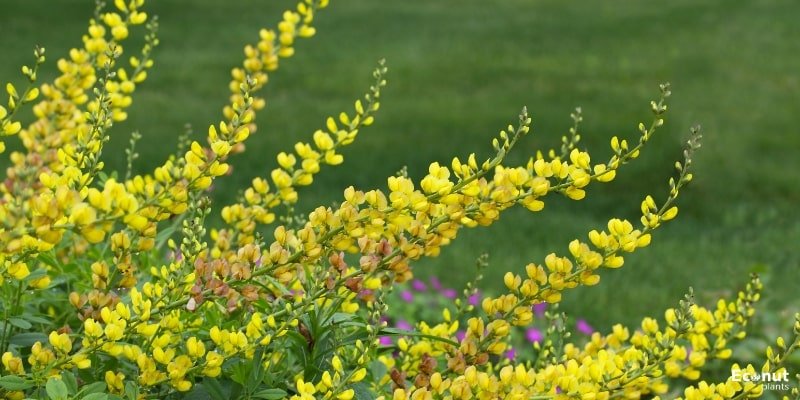
Scientific Name: Baptisia
A gorgeous and long-lasting perennial, Lemon Meringue is a hybrid of baptisia. It grows into an upright, 36-inch-tall, mounded habit fashioned like a vase. Charcoal shafts emerging from blue-green leaves support the lemon-yellow blossoms. Late spring to early summer is when they bloom, and in the autumn, they produce beautiful seed pods to cap off the season.
Its height and the contrast between the blue and yellow foliage colours make it a great focal point for any landscape. It’s a great option for first-time gardeners because it requires minimal upkeep to look its best. This endemic bloom in North America is resistant to drought and deer. It thrives in zones 4 through 9, preferring both shade and sunlight.
15. Banana Cream
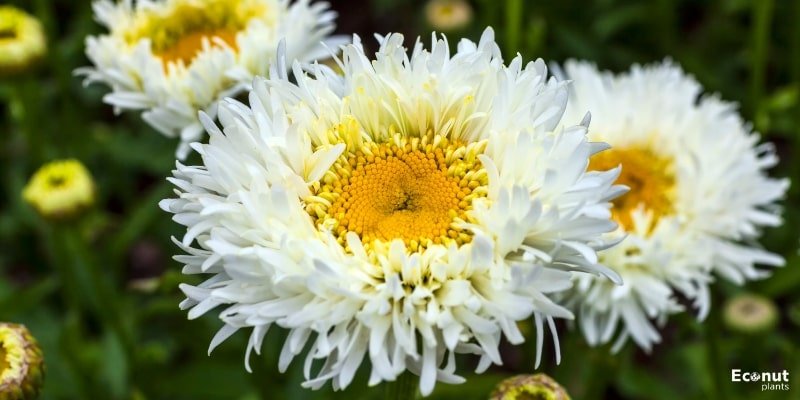
Scientific Name: Leucanthemum superbum
Referencing the banana theme again, this plant was once called Chrysanthemum maximum. Known as a Shasta daisy at times, although it has a white daisy-like appearance, it blooms a lemon yellow colour before gradually changing to a buttery golden hue.
And the blossom turns a creamy white colour once more as it reaches maturity. Who doesn’t adore a flower that changes colour?
One bud can be found on each stem, and the blossom can get as wide as five inches. The leaves are a homogeneous cluster, standing straight and having a dark green colour. They need full to partial light and thrive in zones 5 through 9.
Early to late summer is when the flowers blossom and they do so into autumn. They are reasonably resistant and appropriate for containers for a variety of diseases.
16. Solar Flare

Scientific Name: Kniphofia
Solar flare is a vibrant, sunny bloom that lasts till the very end. It is available in red, orange, and our favourite colour, yellow. The flowers have an erect habit and spiky look, growing up to 42 inches in height. It continues to bloom into the late season, adding to the lovely colour. They are indigenous to South Africa and have a tropical appearance.
The foliage of the Solar Flare, also known as the Red Hot Poker or Torch Lily, resembles grass. They are perfect as focal points or for the center of any border. They require at least six hours of direct sunlight to flourish, and they bloom best in zones 5 through 9. Solar flares add excitement to any garden by drawing hummingbirds and butterflies into it.
17. Bottle Rocket
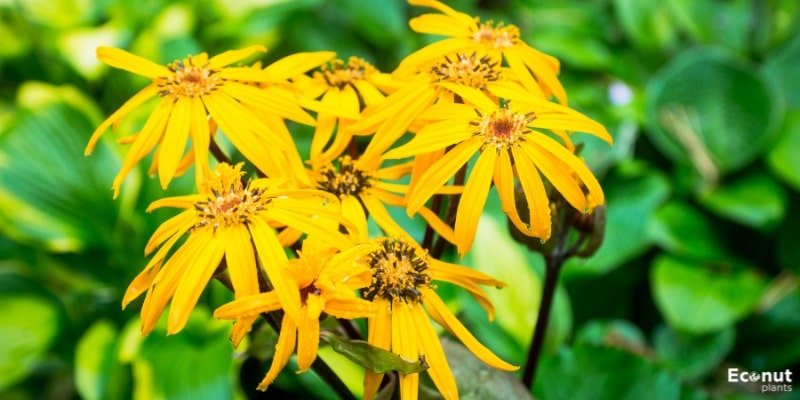
Scientific Name: Ligularia
This stunning perennial with jaggedly serrated stalks that form dramatic clumps is sometimes referred to as the Leopard Plant. The tiny, delicate-looking yellow blossoms emerge from the brown, slender stems. Late summer until early October is when the blooms flourish. The foliage is made up of big, green leaves that can grow up to 36 inches tall.
Bottle rockets prefer protection from the midday sun, although they also tolerate full sun and some shade. As a result, you must adjust your placement. They thrive in containers because you can move them around, which is why.
In the end, zones 4 through 9 work best for this flower. For optimal outcomes, you must monitor their soil, as it needs consistent moisture.
18. Golf Beauty
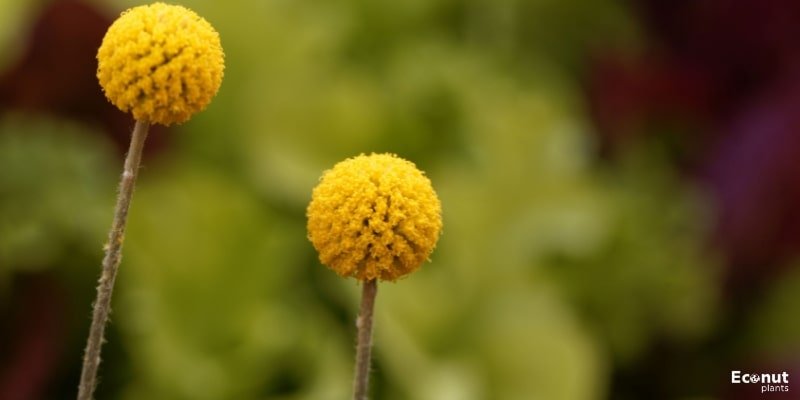
Scientific Name: Craspedia globosa
It is understandable why these flowers are called Golf Beauty—they have one of the most distinctive appearances of any flowers on our list.
Billy Buttons is another name for them that is occasionally used. The golf ball-shaped blossoms are loud and proud wherever they go. They are supported by erect, slender, up to 35-inch-tall silver-green stalks.
It is an evergreen perennial that blooms year-round under the correct circumstances. They are endemic to Australia’s Outback and grow best in bright light and copious amounts of summer water. Eight to eleven are their favourite zones.
Whether cutting fresh or dried bouquets, they are renowned for their exceptional cutting skills. Once established, they are often disease-resistant and require little maintenance.
19. Graham Thomas Rose
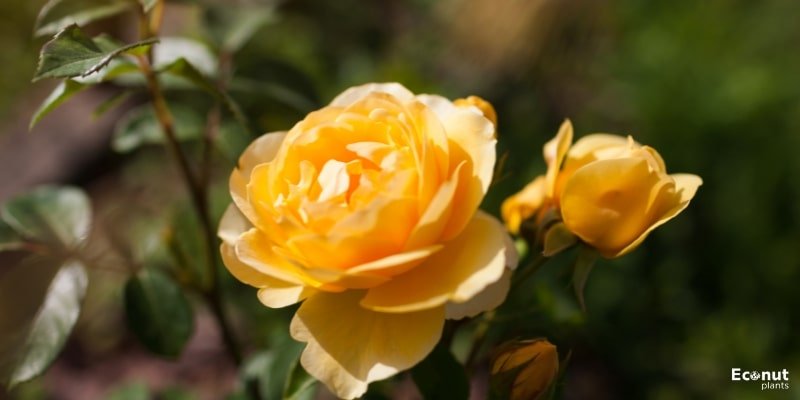
Scientific Name: Rosa
Another essential for any garden that has to make our list is the perennially well-liked Graham Thomas Rose. It has distinctive petals with hints of red and yellow, and it smells very strong.
It has previously taken home several esteemed horticultural accolades and been chosen as the world’s favourite rose. When paired with light blue flowers like lavender or campanula, this rose looks amazing.
A rebloomer, the Graham Thomas Rose can be enjoyed from April until the first frosts. This, along with its minimal maintenance requirements, makes it a worthwhile perennial to have in your landscape.
It is an excellent climbing plant since it is an upright, bushy shrub that may grow to a height of more than 100 inches. It adores the summer heat and does best in zones 5 to 10.
20. Golden Calla Lily
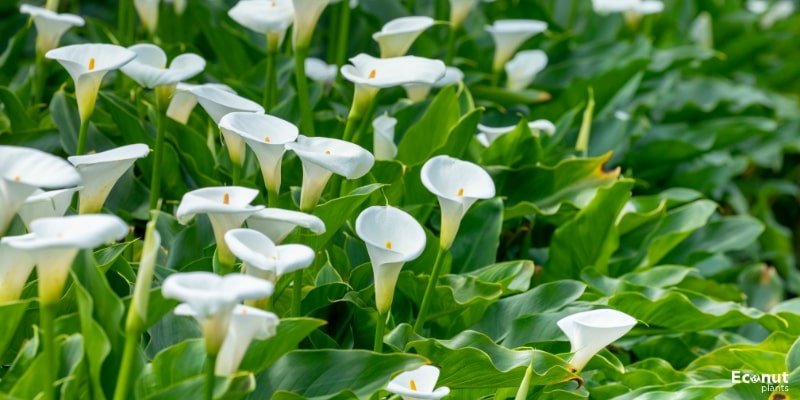
Scientific Name: Zantedeschia elliottiana
A calla lily list wouldn’t be complete without mentioning the unique and beautiful Golden Calla. They are rich in golden tones and tuberous trumpet-shaped flowers. The long, light-green arrowhead leaves, thickly studded with white dots, contrast sharply with the flowers. They are indigenous to South Africa and give any yard a touch of the tropics.
This bright perennial is an award-winning showstopper and is best for focal points, containers, or drifts. También son ideales para cortar flores. They reach heights of 35 inches and require full to partial sun. These flowers are unbelievably easy to care for and look best during the summer and fall seasons.
Conclusion
One may think that yellow flowers are hard to work with. However, you will definitely make them rock your garden and liven up your environment if you use the four planting techniques listed above. Ideally, you now have the sunny inspiration you need after looking over our list of 20 yellow perennial flowers for your garden.

